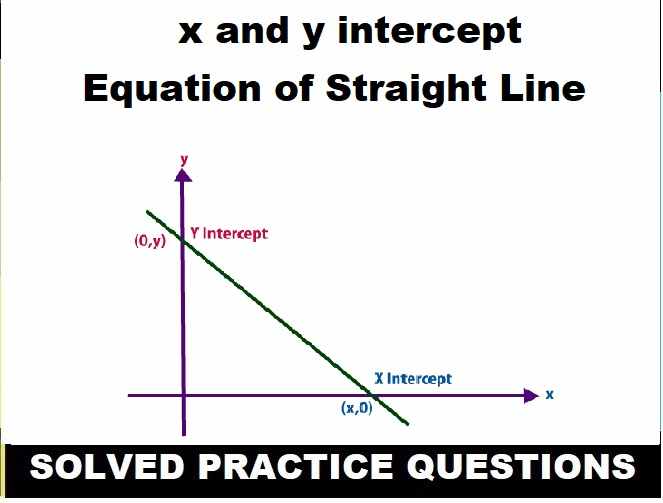Spectrum ICSE Class-10 Concise Physics Solutions Selina Publishers Chapter-6. We Provide Step by Step Answer of Exercise-6(A), MCQs-6(A), Numericals-6(A), Exercise-6(B), MCQ-6(B), Numericals-6(B), Exercise-6(C) and MCQ-6(C) Questions of Exercise-6 Spectrum ICSE Class-10 Concise . Visit official Website CISCE for detail information about ICSE Board Class-10.
| Board | ICSE |
| Publications | Selina Publication |
| Subject | Physics |
| Class | 10th |
| Chapter-6 | Spectrum |
| Book Name | Concise |
| Topics | Solution of Exercise-6(A), MCQs-6(A), Numericals-6(A), Exercise-6(B), MCQ-6(B), Numericals-6(B), Exercise-6(C) and MCQ-6(C) |
| Academic Session | 2021-2022 |
Spectrum ICSE Class-10 Concise Physics Solutions Selina Publishers Chapter-6
-: Select Exercise :-
Exercise-6(A), MCQs-6(A), Numericals-6(A),
Exercise-6(B), MCQ-6(B), Numericals-6(B), Exercise-6(C) and MCQ-6(C)
Note:- Read the chapter Spectrum carefully and then solve the example given in your text book before starting Solution of Chapter – 6 “Spectrum” exercise.
Exercise- 6(A) “Spectrum” Selina Physics Solutions
Page 137
Question 1
Name three factors on which the deviation produced by a prism depends and state how does it depend on the factors stated by you.
Answer 1
The deviation produced by the prism depends on the following four factors:
(a)The angle of incidence – As the angle of incidence increases, first the angle of deviation decreases and reaches to a minimum value for a certain angle of incidence. By further increasing the angle of incidence, the angle of deviation is found to increase.
(b)The material of prism (i.e., on refractive index) – For a given angle of incidence, the prism with a higher refractive index produces a greater deviation than the prism which has a lower refractive index.
(c)Angle of prism- Angle of deviation increases with the increase in the angle of prism.
(d)The colour or wavelength of light used- Angle of deviation increases with the decrease in wavelength of light.
Question 2
How does the deviation produced by a triangular prism depend on the colour (or wavelength) of light incident on it?
Answer 2
The deviation caused by a prism increases with the decrease in the wavelength of light incident on it.
Question 3
How does the speed of light in glass change on increasing the wavelength of light?
Answer 3
Speed of light increases with increase in the wavelength
Question 4
Which colour of white light travels (a) fastest (b) slowest, in glass?
Answer 4
Red colour travels fastest and Blue colour travels slowest in glass.
Question 5
Name the subjective property of light related to its wavelength.
Answer 5
Colour of light is related to its wavelength.
Question 6
What is the range of wavelength of the spectrum of white light in (i) ![]() and (ii) nm?
and (ii) nm?
Answer 6
(i) ![]()
(ii) 400 nm to 800 nm
Question 7
(a) Write the approximate wavelengths for (i) blue and (ii) red light.
(b) The wavelengths of violet and red light are 4000 respectively. Which of the two has the higher frequency?
Answer 7
(a)
(i)For blue light, approximate wavelength=4800
(ii)For red light, approximate wavelength=8000
(b) violet has high frequency.
Question 8
Write the seven prominent colours present in white light spectrum in order of their increasing wavelength.
Answer 8
Seven prominent colours of the white light spectrum in order of their increasing frequencies:
Red, Orange, Yellow, Green, Blue, Indigo, Violet
Question 9
Name the seven prominent colours of the white light spectrum in order of their increasing frequencies.
Answer 9
The seven colours in the order of increasing frequencies are red, orange, yellow, green, blue, indigo and violet.
Question 10
Name four colours of the spectrum of white light which have wavelength longer than blue light.
Answer 10
Green, Yellow orange and red have wavelength longer than blue light.
Question 11
Which colour of white light is deviated by a glass prism (i) the most and, (ii) which the least?
Answer 11
A glass prism deviates the violet light most and the red light least.
Question 12 (Spectrum ICSE Class-10 Concise Selina)
The wavelengths for the light of red and blue colours are roughly 7.8 x 10-7m and 4.8 x 10-7 m respectively.
(a)Which colour has the greater speed in vacuum?
(b)Which colour has the greater speed in glass?
Answer 12
(a)In vacuum, both have the same speeds.
(b)In glass, red light has a greater speed
Page 138
Question 13
Define the term dispersion of light.
Answer 13
The phenomenon of splitting of white light by a prism into its constituent colours is known as dispersion of light.
Question 14
Explain the cause of dispersion of white light through a prism.
Answer 14
When white light is incident on the first surface of a prism and enters in glass, light of different colours due to different speeds in glass, is refracted or deviated through different angles. Thus the dispersion of white light into its constituent colours takes place at the first surface of prism. Thus the cause of dispersion is the change in speed of light with wavelength or frequency.
Question 15
Explain briefly, with the help of a neat labelled diagram, how white light gets dispersed by a prism.
on Which surface of prism, there is both the dispersion and deviation of light, and on which surface of prism, there is only the deviation of light?
Answer 15
When white light is incident on the first surface of a prism and enters in glass, light of different colours due to different speeds in glass, is refracted or deviated through different angles. Thus the dispersion of white light into its constituent colours takes place at the first surface of prism.
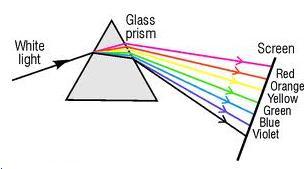
On the second surface, only refraction takes place and different colours are deviated through different angles. As a result, the colours get further separated on refraction at the second surface (violet being deviated the most and red the least).
Question 16
What do you understand by the term spectrum?
Answer 16
The colour band obtained on a screen on passing white light through a prism is called the spectrum.
Question 17
A ray of white light is passed through a glass prism and spectrum is obtained on a screen.
(a)Name the seven colours of the spectrum in order.
(b)Do the colours have the same width in the spectrum?
(c)Which of the colour of the spectrum of white light deviates (i) the most? (ii) the least?
Answer 17
(a)Violet, Indigo, Blue, Green, Yellow, Orange, Red.
(b)No, different colours have different widths in the spectrum.
(c)(i) Violet colour is deviated the most. (ii) Red colour is deviated the least.
Question 18
The diagram shown below shows the path taken by a narrow beam of yellow monochromatic light passing through an equiangular glass prism. Now the yellow light is replaced by a narrow beam of white light incident at the same angle. Draw another diagram to show the passage of the beam through the prism and label it to show the effect of prism on the white light.
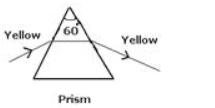
Answer 18
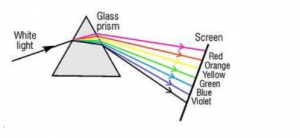
Question 19 (Spectrum ICSE Class-10 Concise Selina)
Figure shows a thin beam of white light from a source S striking on one face of a prism.
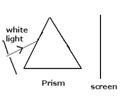
(a) Complete the diagram to show the effect of prism on the beam and to show what is seen on the screen.
(b) A slit is placed in between the prism and the screen to pass only the light of green colour. What will you then observe on the screen?
(c) What conclusion do you draw from the observation in part (b) above?
Answer 19
(a)Constituent colours of white light are seen on the screen after dispersion through the prism.
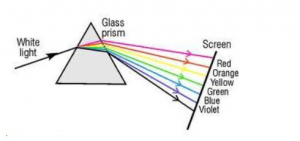
(b)When a slit is introduced in between the prism and screen to pass only the light of green colour, only green light is observed on the screen.
(c)From the observation, we conclude that prism itself produces no colour.
Question 20
(a) A beam of monochromatic light undergoes minimum deviation through an equiangular prism, how does the beam pass through the prism, with respect to its base?
(b) If white light is used in same way as in part (a) above, what change is expected in the emergent beam?
(c) What conclusion do you draw about the nature of white light in part (b)?
Answer 20
(a) If a monochromatic beam of light undergoes minimum deviation through an equi-angular prism, then the beam passes parallel to the base of prism.
(b) White light splits into its constituent colours i.e., spectrum is formed.
(c) We conclude that white light is polychromatic.
Multiple Choice Type – 6(A) “Spectrum” Selina Concise ICSE Class-10 Physics Solution
Page 138
Question 1
When a white light ray falls on a prism, the ray at its first surface suffers:
(a) No refraction
(b) Only dispersion
(c) Only deviation
(d) Both deviation and dispersion
Answer 1
Both deviation and dispersion.
Hint: When a white light ray falls on the first surface of a prism, light rays of different colours due to their different speeds in glass get refracted (or deviated) through different angles. Thus, the dispersion of white light into its constituent colours takes place at the first surface of prism.
Question 2
In the spectrum of white light by a prism, the colour of the extreme end opposite to the base of prism is:
(a) Violet
(b) Yellow
(c) Red
(d) Blue
Answer 2
The colour of the extreme end opposite to the base of the prism is red.
Hint: The angle of deviation decreases with the increase in wavelength of light for a given angle of incidence. Since the red light has greatest wavelength, it gets deviated the least and is seen on the extreme end opposite to the base of prism.
Question 3
The wavelength range of white light is:
(a) 4000 nm to 8000 nm
(b) 40 nm to 80 nm
(c) 400 nm to 800 nm
(d) 4 nm to 8 nm
Answer 3
The wavelength range for white light is 400 nm to 800 nm or 4000 Å to 8000 Å.
NUMERICALS – 6(A),“Spectrum” ICSE Class-10
Page 138
Question 1
Calculate the frequency of yellow light of wavelength 550 nm. The speed of light is 3 x 108 ms-1.
Answer 1

Question 2
The frequency range of visible light is from 3.75 x 1014 Hz to 7.5 x 1014Hz. Calculate its wavelength range. Take the speed of light =3 x 108m/s.
Answer 2
Speed of light, c= 3x 108m/s
Frequency range=3.75 x 1014Hz to 7.5 x 1014Hz.
Speed of light = frequency x wavelength
For frequency=3.75 x 1014Hz
For frequency =7.5 x 1014Hz
Return to Concise Selina ICSE Physics Class-10
Thanks


